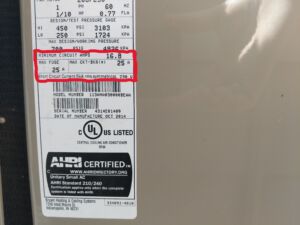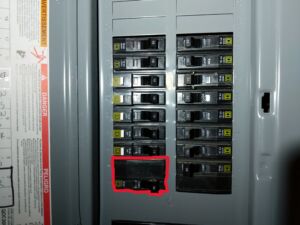
An electrical circuit for any electric powered appliance is protected by a circuit breaker at the electrical panel. The size of the wire, the operating current load of the appliance, and the amperage rating of the circuit breaker all must align to prevent damage to equipment or fire hazards. A circuit breaker is a safety device that is designed to shut off electrical current when the current load at that circuit exceeds the amperage rating that corresponds with that breaker. If the breaker is oversized, the wiring and appliance could experience dangerously high levels of electricity prior to the circuit breaker shutting off power to the system. Alternatively, if a circuit breaker has too low of an amperage rating, the circuit breaker may shut off power continuously and interrupt service to this given electrical circuit.
Air conditioning systems are designed with specific electrical requirements that dictate the size of the circuit breaker necessary to protect the equipment. The manufacturer’s recommended breaker size ensures that the electrical current flowing through the system remains within safe limits. Installing a larger circuit breaker compromises the protective measures established by the manufacturer, potentially subjecting the equipment to excessive current loads. This can lead to overheating, component failure, and even fire hazards. By adhering to the recommended breaker size, users safeguard their equipment, extend the lifespan of the air conditioning system, and avoid costly repairs or replacements. Altering the electrical specifications of an air conditioning system, such as installing a larger breaker, may void the manufacturer’s warranty. It is essential to comply with the recommended guidelines to ensure that any warranty claims remain valid.

All work at the electrical panel should be performed by a licensed and bonded electrician. Working with circuit breakers involves exposure to live electrical components. Without proper knowledge and understanding of electrical systems, there is a higher risk of electric shock, which can result in serious injury or even death. Electricians receive extensive training on electrical safety to mitigate these risks. Additionally, all work and repairs made at the electrical panel should be permitted. Although a homeowner can perform these repairs and have the work approved by local jurisdiction, a local electrician is well versed in the local code and will ensure all repairs are code compliant to avoid any safety or legal repercussions. As mentioned previously, ensuring that the correct gauge wire, appropriate current load for the given electrical circuit, and corresponding circuit breaker amperage are all present is imperative. All these considerations may require experienced and expert analysis that should be performed by a licensed and bonded electrician.
Installing a circuit breaker larger than the manufacturer’s recommended size for an air conditioning system poses several risks that can compromise equipment protection and fire safety. Following the manufacturer’s guidelines is essential for maintaining a safe and efficient operation of the air conditioning system. Ultimately, responsible adherence to these guidelines ensures a comfortable, safe, and reliable indoor environment for years to come.
